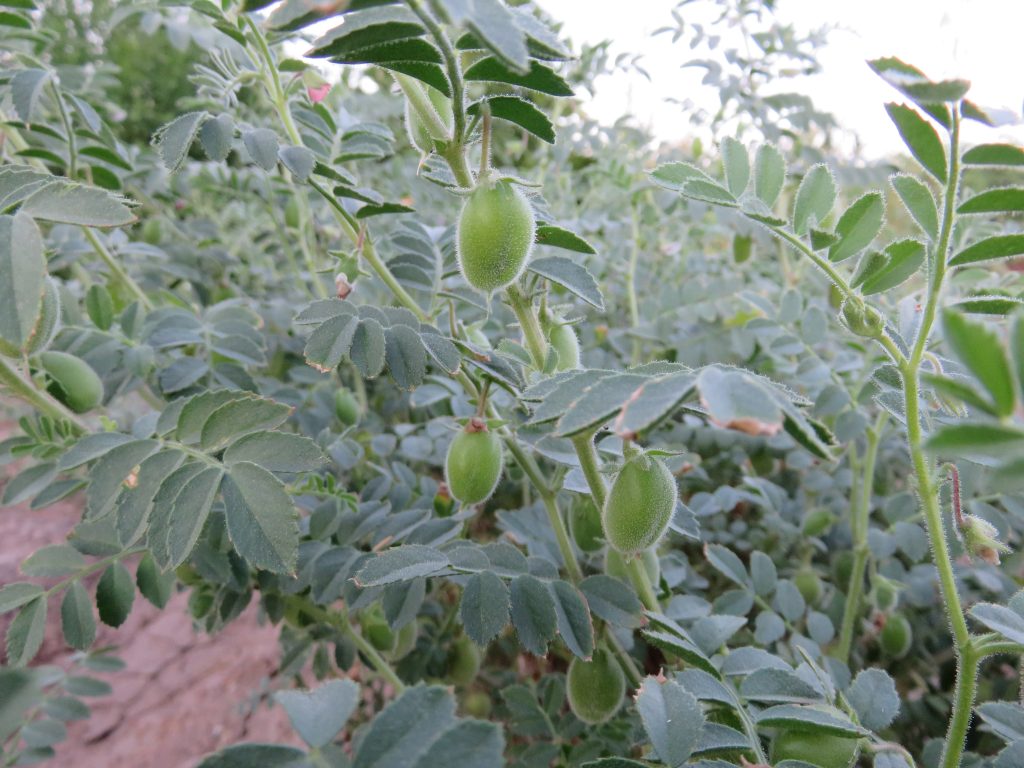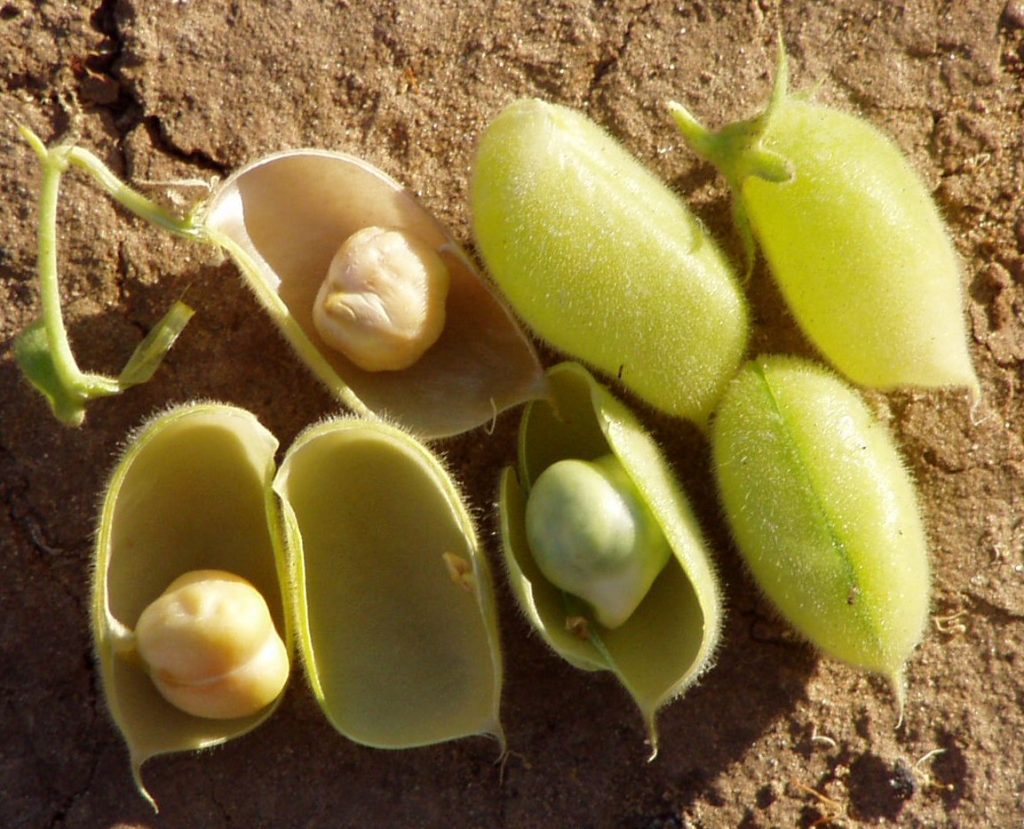Chickpea (Cicer arietinum)
Patricia Henderson
Colorado State University, Fort Collins, Colorado 80523
Corresponding author: patricia.henderson@colostate.edu; patrick.byrne@colostate.edu
OUTLINE
- Overview
- History
- Production and use
- Conservation and breeding
- Recipes
- References
- Chapter information
1. OVERVIEW

Chickpea (Cicer arietinum) is the world’s second most important grain legume in terms of area and third most important by production. It is an annual, diploid, and predominantly self-pollinated species. Chickpeas are renowned for their high nutritional value and ability to contribute to soil health. While chickpeas are mainly grown in cooler seasons of arid and semi-arid regions, selective breeding has introduced traits allowing them to be resistant to heat stress and less favorable environmental conditions (Sedláková et al., 2021). As a staple crop across Southern Asia, chickpea plays an important part in the diets of millions of people (Merga et al., 2019), making the conservation of its genetic resources a major concern. Chickpeas have important culinary uses as dal in South Asian cuisine and hummus in the Middle East.
2. HISTORY

The cultivation of chickpeas dates back as early as the Bronze Age, around 5,000 years ago (CGIAR Genebank Platform, 2019). It is thought to have been domesticated within the Fertile Crescent, specifically southeast Turkey (CGIAR Genebank Platform, 2019). The cultivated species we grow today, Cicer arietinum, is a probable descendant of the wild species, Cicer reticulatum (Sedláková et al., 2021). There are several key differences between the two species, the most prominent being that cultivated chickpeas are larger in plant mass, have reduced seed dormancy, and have a decreased likelihood of pod shattering (Sedláková et al., 2021).
These traits are desirable in food crops because they allow easier seed collection, larger crop yield, and lower sensitivity to environmental conditions. For example, the wild relative C. reticulatum disperses its seeds through shattering of the pods, a common trait in non-cultivated plants. Shattering occurs when the pod ‘explodes’ in order to scatter the seeds, instead of staying together and being easier to harvest and resupply plantable seeds for the next planting season.
The lower need for vernalization and reduced seed dormancy, as well, allow for more flexibility as to when and where the domesticated species can be planted. In nature, seed dormancy helps align the time of germination with optimal environmental conditions. In cultivation, however, reduced dormancy is desirable because it allows for more flexible planting dates, a longer growing season, more uniform germination, and higher crop yield.
3. PRODUCTION AND USE

On a global scale, chickpeas are the second most important grain legume crop by area and third most important by production (CGIAR Genebank Platform, 2019). As of 2019, India was responsible for about 70% of chickpea production worldwide (FAO of the United Nations, 2022). Other major producers are Australia, Myanmar, Pakistan. and Turkey. This follows the pattern of chickpea production and consumption occurring mainly within South and Southeast Asia, the Middle East, and the Mediterranean regions (CGIAR Genebank Platform, 2019).
Chickpeas are grown in a variety of different climates and countries around the world. They can be grown as food crops, feed for livestock, and used for nitrogen fixation (Merga et al., 2019). While chickpeas tend to prefer cooler seasons, significant efforts have been made to improve their tolerance to drought and heat stress as of late, making it less of a risk to plant chickpeas in warmer environmental conditions (Devasirvatham & Tan, 2018). On top of these recent adaptations, this crop is already accustomed to unfavorable soil conditions and cooler climates (Taranova et al., 2021).
Out of 43 species in the Cicer genus, only C. arietinum has been cultivated. Of this single species, there are two commonly recognized types: Desi and Kabuli. Desi chickpeas, commonly found in India and Ethiopia, have small, angular seeds with rough seed coats. They are assumed to be closer to their wild ancestor, C. reticulatum, than Kabuli types, as they have a bushy growth habit and purple-blue flowers (CGIAR Genebank Platform, 2019). Kabuli chickpeas (also known as garbanzo beans), on the other hand, are commonly grown in Mediterranean regions and tend to have large, rounded seeds with smooth seed coats that are beige in color (CGIAR Genebank Platform, 2019). They tend to have a more upright growth habit and white flowers. Both types play a significant part in local trade within their respective regions.
In general, grain legumes or pulses are an essential part of the diets of developing countries. This is due to their elevated levels of protein, iron, calcium, and other vital minerals (Merga et al., 2019). Chickpeas have one of the best nutritional profiles among grain legumes (CGIAR Genebank Platform, 2019). They are extremely high in protein, with an average of around 23% but as high as 32%, and around 8% fat (Merga et al., 2019). Chickpeas lack the toxic and anti-nutritional properties found in some legumes (CGIAR Genebank Platform, 2019). The crop can meet up to 80% of its nitrogen requirement; as with all legumes, it plays an important part maintaining soil health through nitrogen fixation (CGIAR Genebank Platform, 2019).
4. CONSERVATION AND BREEDING

In genebanks, chickpeas are usually conserved as dried seeds in cold storage under low moisture conditions to maintain seed viability for as long as possible (CGIAR Genebank Platform, 2019). Different genetic strains, known as accessions, are maintained and reproduced separately to preserve their genetic purity.
Worldwide, there are more than 80,000 accessions estimated to be conserved in over 30 gene banks (CGIAR Genebank Platform, 2019). The collections consist of a mix of cultivars, landraces, breeding lines, and wild species, with wild accessions making up less than 2% of the total. Some of the genebanks with major collections, defined as more than 5,000 accessions, are the International Center for Agricultural Research in the Dry Areas (ICARDA), the International Crops Research Institute for the Semi-Arid Tropics (ICRISAT), the Australian temperate field crops collection, the National Bureau of Plant Genetic Resources in India, the Seed and Plant Improvement Institute in Iran, and the National Plant Germplasm System in the USA (CGIAR Genebank Platform, 2019).
There are active breeding programs at ICARDA, ICRISAT, and national programs. With the expected increased severity and frequency of droughts, current breeding objectives have focused on improving adaptation to heat and drought stress (Devasirvathan & Tan, 2018). Ensuring that chickpeas are able to maintain a stable yield level under adverse conditions will help combat the effects predicted under climate change. Increasing overall productivity, as well as narrowing the gap between predicted yield potential and actual crop yield, is one of several important goals for chickpea breeding in the long-term (Devasirvatham & Tan, 2018).
5. RECIPES

Some good recipes with chickpeas can be found at the following sites:
- bonappetit.com/recipes/slideshow/chickpea-recipes
- loveandlemons.com/chickpea-recipes
- allrecipes.com/recipes/16980/fruits-and-vegetables/beans-and-peas/garbanzo-beans
6. REFERENCES
CGIAR Genebank Platform. 2019. Chickpea. CGIAR Genebank Platform. Accessed 24 July, 2022. Available from: genebanks.org/resources/crops/chickpea
Devasirvatham V, Tan DKY. 2018. Impact of high temperature and drought stresses on chickpea production. Agronomy 8:145. DOI: 10.3390/agronomy8080145
Food and Agriculture Organization of the United Nations. 2022. Crops and livestock products. FAOSTAT. Accessed 26 July, 2022. Available from: fao.org/faostat/en/#data/QCL
Merga B, Haji J, Yildiz F. 2019. Economic importance of chickpea: production, value, and world trade. Cogent Food & Agriculture 5:1615718. DOI: 10.1080/23311932.2019.1615718
Sedláková V, Hanáček P, Grulichová M, Zablatzká L, Smýkal P. 2021. Evaluation of seed dormancy, one of the key domestication traits in chickpea. Agronomy 11:2292. DOI: 10.3390/agronomy11112292
Taranova ES, Zenina EA, Mel’nikov AG, Kryuchkova TE, Skorokhodov EA, Ileneva SV. 2021. Use of chickpea flour in food production. IOP Conference Series. Earth and Environmental Science 845:12120. DOI: 10.1088/1755-1315/845/1/012120
7. CHAPTER INFORMATION
Chapter citation: Henderson P. 2023. Chickpea (Cicer arietinum). In: Chen K, Byrne P (Eds.) Understudied Indigenous Crops. Fort Collins, Colorado: Colorado State University. Date accessed. Available from https://colostate.pressbooks.pub/understudiedindigenouscrops/chapter/chickpea/
Chapter editor: Patrick Byrne

